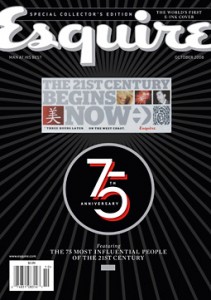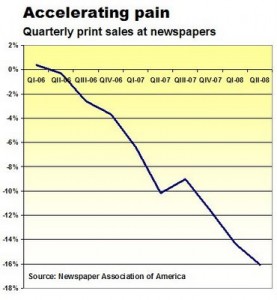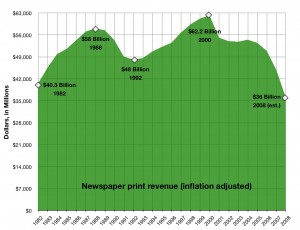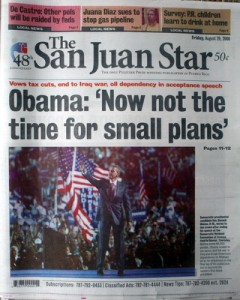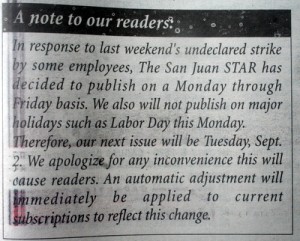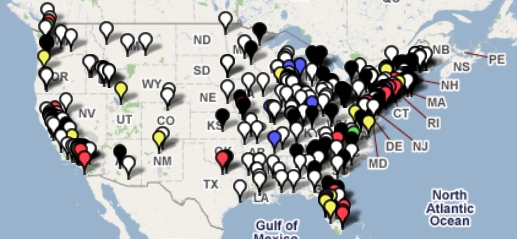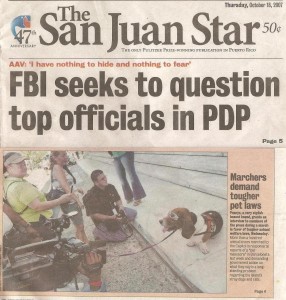The Newark Star-Ledger quit the Associated Press cold turkey – but just for one day. New Jersey’s largest daily, which is hemorrhaging money, tried publishing en entire issue on Wednesday without any AP copy, relying instead upon feeds from a variety of alternative services.
Was it a protest against the news cooperative’s new rate structure or a test to see if there is life after AP? The paper isn’t saying. However, what the AP is saying publicly amounts to giving the newspaper industry the finger.
Responding to inquiries about the Star-Ledger boycott, AP spokesman Paul Colford sent Editor & Publisher a vapid statement that concluded that the service’s new pricing plan, called Member Choice, “was in fact developed as a response to member requests for simpler content and pricing options.” In other words, if members don’t like the new rate structure, it’s their own fault.
The new plan offers a lower-cost core service of national, state and international news. Subscribers can then buy add-on subscription or individual stories instead of paying by volume of news delivered, which was the old pricing plan. AP says 90% of its customers save money under the new structure.
It’s surprising, though, that the lucky majority is so silent while several party poopers threaten loudly to quit. Why aren’t the many customers that are so pleased with the new plan shouting them down? Maybe Paul Colford should hit the phones a little harder.
Or perhaps the AP’s real attitude is summed up in comments by its Executive Editor, Kathleen Carroll, to a group of newspaper editors, In an E&P article generously titled “We Can Work It Out,” Carroll is quoted as saying “We certainly hope that the basic fundamentals of the economy and the marketplace will firm up enough so that the pressure is off some of the people who own the AP.”
In other words, we’re not changing a thing. If business doesn’t get better, then have a nice life.
Like co-dependent substance abusers, the question for the AP and its members is who needs the other more. Alan Mutter published a cogent analysis last month concluding that the AP would have a hard time getting by without its largest members. Many newspapers are experimenting with innovative arrangements for sharing stories that end-run the wire, perhaps in preparation for an AP-less existence. Meanwhile, there are reports that the AP is shoring up its broadcast and Internet businesses in case its newspaper members start quitting en masse.
One of the big problems facing newspapers is that information is becoming free. It’s not surprising that they might be wondering why they still need to pay the AP so much to get it.
NAA Goes Web 2.0
Perhaps financially challenged newspaper executives can commiserate by throwing sheep at each other. The Newspaper Association of America will launch NAA.org Community this fall. It’s a social network that will provide forums, personal profiles, user ratings, keyword tags, photo- and video-sharing and RSS feeds. Users will also be able to share files and send private messages within the community. The stage site is here. The home page also says you can use the site’s Community Blogs list to “find blogs about the newspaper industry, written by leading experts.” We don’t expect to make the list.
Dated Newspaper Story Triggers Airline Stock Plunge
A Google search bot triggered a 75% plunge in shares of United Airlines over the weekend when it assigned a Sept. 6, 2008 date to a six-year-old story about United Airlines’ bankruptcy filing. Although the stock had recovered all but 10% of its value by midweek, officials at the South Florida Sun Sentinel, parent Tribune Co. and Google were trying to sort out the mess and pointing a few fingers.
No one was saying why the story popped up on the Sun-Sentinel website at about 1 a.m. Sunday in the first place. Whatever, the reason, the Google News search bot quickly picked it up. Because the story lacked a time stamp, Google News automatically assigned that day’s date to it (note to Google: you might want to revisit this policy), and that’s when all hell broke loose. A few minutes later, traffic from Google began to pour in. It remained heavy all day Sunday, making the story one of the most viewed on the Sun-Sentinel site. On Monday morning, an investor forwarded the story to Bloomberg News, which posted it to its subscribers. Bloomberg quickly issued a retraction, but the damage had been done.
The question hanging over the whole fiasco: who are investors going to name in the class action suit?
Say It Ain’t Zell!
Is Sam Zell gearing up to buy the San Diego UnionNews-Tribune? That’s the word on the street, according to this E&P account. With Tribune Co. barely able to meet its existing debt obligations, it seems doubtful that Sam Zell would want to make an acquisition, but hey, you have to admit that the name fits well.
And Finally…
Esquire‘s 75th-anniversary issue has hit the newsstands, and 100,000 copies of the 725,000-circ monthly are using some eyebrow-raising technology to add a digital feel. A 10-inch-square-inch display on the cover of the issue flashes the theme “The 21st Century Begins Now” with a collage of illuminated images. On the inside cover, a two-page spread by Ford also has a 10-square-inch display with shifting colors to illustrate the car in motion at night.
The stunt can’t have been cheap. Media Bistro says it involved Chinese electronics that came by refrigerated truck via Dallas to a Mexican manufacturing facility, which assembled the conductive ink engines that energize the display. The cover show is powered by batteries that were themselves printed in conductive ink. The displays were developed by E-Ink Corp.
